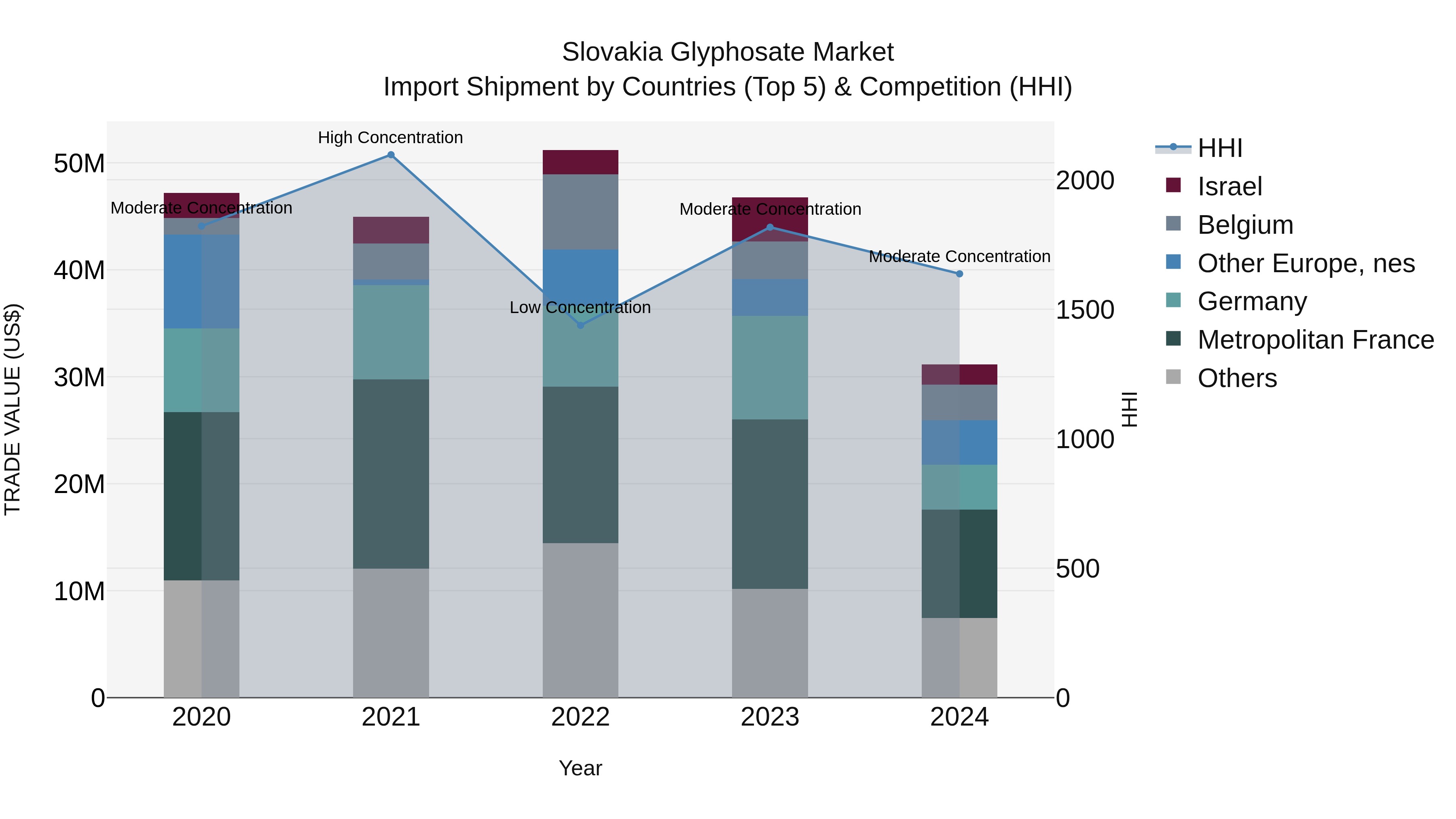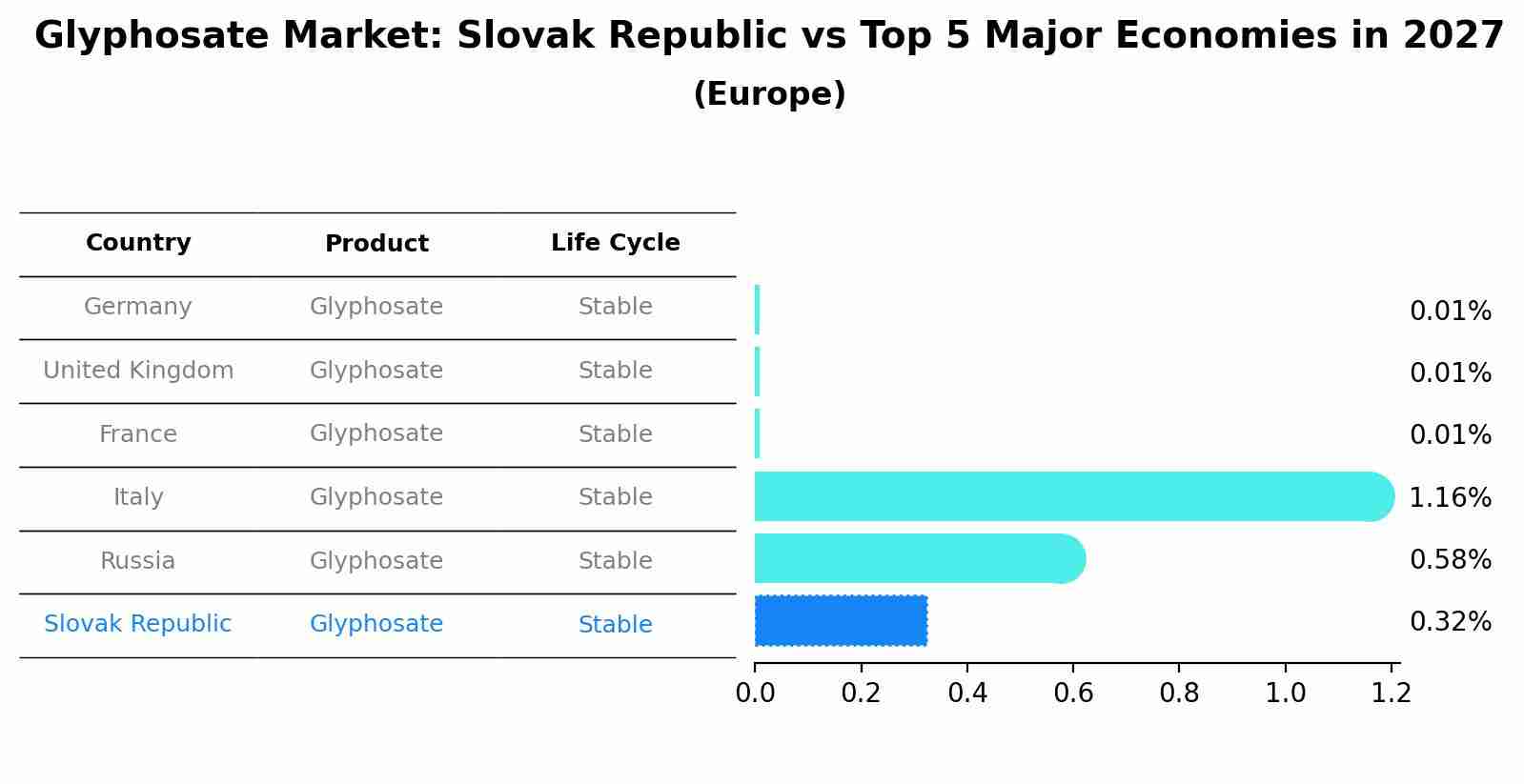Slovakia Glyphosate Market Outlook | COVID-19 IMPACT, Trends, Value, Forecast, Analysis, Industry, Companies, Revenue, Share, Growth & Size
| Product Code: ETC415756 | Publication Date: Oct 2022 | Updated Date: Nov 2025 | Product Type: Market Research Report | |
| Publisher: 6Wresearch | Author: Ravi Bhandari | No. of Pages: 75 | No. of Figures: 35 | No. of Tables: 20 |
Slovakia Glyphosate Market Top 5 Importing Countries and Market Competition (HHI) Analysis
In 2024, Slovakia continued to import glyphosate primarily from Metropolitan France, Germany, and other European countries. The Market Top 5 Importing Countries and Market Competition (HHI) Analysis showed moderate concentration with a declining trend, reflected by a negative compound annual growth rate of -9.86% from 2020 to 2024. The growth rate in 2024 saw a significant decrease of -33.39%, indicating potential shifts in Market Top 5 Importing Countries and Market Competition (HHI) Analysis dynamics. With key suppliers from various European nations, Slovakia`s glyphosate import Market Top 5 Importing Countries and Market Competition (HHI) Analysis appears to be evolving amidst changing conditions.

Glyphosate Market: Slovak Republic vs Top 5 Major Economies in 2027 (Europe)
In the Europe region, the Glyphosate market in Slovak Republic is projected to expand at a stable growth rate of 0.32% by 2027. The largest economy is Germany, followed by United Kingdom, France, Italy and Russia.

Slovakia Glyphosate Market Synopsis
The Slovakia Glyphosate Market is influenced by factors such as increasing adoption of genetically modified crops, growth in the agriculture sector, and the need for efficient weed control solutions. Glyphosate-based herbicides are widely used in Slovakia for their effectiveness in controlling a broad spectrum of weeds. The market is dominated by key players offering a range of glyphosate products for different crop types. However, there is a growing concern regarding the potential health and environmental risks associated with glyphosate, leading to regulatory scrutiny and shifts towards alternative weed control methods. Despite these challenges, the Slovakia Glyphosate Market is expected to continue growing, driven by the demand for high-yield crop production and sustainable agriculture practices.
Slovakia Glyphosate Market Trends
In Slovakia, the Glyphosate market is witnessing a shift towards sustainable and environmentally friendly alternatives due to increasing concerns about the potential health and environmental impacts of Glyphosate-based products. There is a growing demand for organic and non-toxic weed control solutions among farmers and consumers. Government regulations are also playing a significant role in shaping the market dynamics, with stricter guidelines being implemented to restrict the use of Glyphosate in agriculture. As a result, there is a rising interest in bio-based herbicides and integrated weed management strategies that offer effective weed control while minimizing the reliance on Glyphosate. Overall, the Slovakia Glyphosate market is moving towards a more sustainable and eco-conscious direction, driven by evolving consumer preferences and regulatory pressures.
Slovakia Glyphosate Market Challenges
In the Slovakia Glyphosate Market, there are several challenges that industry players face. One significant challenge is the increasing regulatory scrutiny and public concerns regarding the safety and environmental impact of glyphosate-based products. This has led to stricter regulations and potential bans on the use of glyphosate in agricultural practices, impacting the market demand for such products. Additionally, the emergence of alternative and more sustainable weed control solutions further intensifies the competition in the market. Market players also need to navigate the complexities of ensuring compliance with evolving regulations while maintaining product efficacy and meeting the changing demands of the agriculture sector. Overall, the Slovakia Glyphosate Market faces challenges related to regulatory pressures, consumer perceptions, competition from alternatives, and sustainability concerns.
Slovakia Glyphosate Market Investment Opportunities
Investment opportunities in the Slovakia Glyphosate Market include the potential for growth in demand due to the country`s agriculture sector relying heavily on glyphosate-based herbicides for weed control. As Slovakia continues to modernize its agricultural practices and increase crop production efficiency, the use of glyphosate is expected to rise. Investors could consider opportunities in glyphosate production, distribution, or research and development of alternative herbicides to cater to the evolving market demands. Additionally, investing in sustainable agriculture practices and technologies could appeal to environmentally conscious consumers and align with the global trend towards reducing glyphosate usage. Conducting thorough market research and staying informed about regulatory developments and consumer preferences will be crucial for making informed investment decisions in the Slovakia Glyphosate Market.
Jordan Agar Market Government Policies
In Slovakia, government policies related to the use of glyphosate, a commonly used herbicide, are in line with European Union regulations. The Slovakian government follows the EU`s decision to renew the approval of glyphosate for a limited period, subject to certain restrictions and guidelines aimed at minimizing risks to human health and the environment. These regulations include restrictions on the use of glyphosate in public spaces, such as parks and playgrounds, as well as requirements for labeling and usage instructions on products containing glyphosate. The government also supports research and monitoring efforts to assess the impact of glyphosate on biodiversity and ecosystems, with a focus on sustainable agricultural practices and alternative solutions to reduce reliance on glyphosate in the long term.
Slovakia Glyphosate Market Future Outlook
The future outlook for the Slovakia Glyphosate Market appears to be stable with moderate growth expected in the coming years. Factors such as increasing adoption of modern agricultural practices, rising demand for high-yield crops, and the need for effective weed control solutions are likely to drive the demand for glyphosate in Slovakia. However, regulatory concerns related to the environmental impact of glyphosate and the potential shift towards more sustainable farming practices may pose some challenges for market growth. Overall, with ongoing technological advancements in agriculture and a growing focus on precision farming, the Slovakia Glyphosate Market is expected to maintain a steady growth trajectory in the foreseeable future.
Key Highlights of the Report:
- Slovakia Glyphosate Market Outlook
- Market Size of Slovakia Glyphosate Market, 2021
- Forecast of Slovakia Glyphosate Market, 2031
- Historical Data and Forecast of Slovakia Glyphosate Revenues & Volume for the Period 2018 - 2031
- Slovakia Glyphosate Market Trend Evolution
- Slovakia Glyphosate Market Drivers and Challenges
- Slovakia Glyphosate Price Trends
- Slovakia Glyphosate Porter's Five Forces
- Slovakia Glyphosate Industry Life Cycle
- Historical Data and Forecast of Slovakia Glyphosate Market Revenues & Volume By Application for the Period 2018 - 2031
- Historical Data and Forecast of Slovakia Glyphosate Market Revenues & Volume By Genetically Modified (GM) Crops for the Period 2018 - 2031
- Historical Data and Forecast of Slovakia Glyphosate Market Revenues & Volume By Conventional Crops for the Period 2018 - 2031
- Slovakia Glyphosate Import Export Trade Statistics
- Market Opportunity Assessment By Application
- Slovakia Glyphosate Top Companies Market Share
- Slovakia Glyphosate Competitive Benchmarking By Technical and Operational Parameters
- Slovakia Glyphosate Company Profiles
- Slovakia Glyphosate Key Strategic Recommendations
Frequently Asked Questions About the Market Study (FAQs):
1 Executive Summary |
2 Introduction |
2.1 Key Highlights of the Report |
2.2 Report Description |
2.3 Market Scope & Segmentation |
2.4 Research Methodology |
2.5 Assumptions |
3 Slovakia Glyphosate Market Overview |
3.1 Slovakia Country Macro Economic Indicators |
3.2 Slovakia Glyphosate Market Revenues & Volume, 2021 & 2031F |
3.3 Slovakia Glyphosate Market - Industry Life Cycle |
3.4 Slovakia Glyphosate Market - Porter's Five Forces |
3.5 Slovakia Glyphosate Market Revenues & Volume Share, By Application, 2021 & 2031F |
4 Slovakia Glyphosate Market Dynamics |
4.1 Impact Analysis |
4.2 Market Drivers |
4.2.1 Increasing demand for efficient weed control solutions in agriculture sector |
4.2.2 Adoption of modern farming techniques and technologies |
4.2.3 Government support for agriculture and use of glyphosate-based products |
4.3 Market Restraints |
4.3.1 Growing concerns about environmental and health impacts of glyphosate |
4.3.2 Regulatory restrictions and bans on glyphosate in some regions |
4.3.3 Competition from alternative weed control products and methods |
5 Slovakia Glyphosate Market Trends |
6 Slovakia Glyphosate Market, By Types |
6.1 Slovakia Glyphosate Market, By Application |
6.1.1 Overview and Analysis |
6.1.2 Slovakia Glyphosate Market Revenues & Volume, By Application, 2021-2031F |
6.1.3 Slovakia Glyphosate Market Revenues & Volume, By Genetically Modified (GM) Crops, 2021-2031F |
6.1.4 Slovakia Glyphosate Market Revenues & Volume, By Conventional Crops, 2021-2031F |
7 Slovakia Glyphosate Market Import-Export Trade Statistics |
7.1 Slovakia Glyphosate Market Export to Major Countries |
7.2 Slovakia Glyphosate Market Imports from Major Countries |
8 Slovakia Glyphosate Market Key Performance Indicators |
8.1 Adoption rate of glyphosate-resistant crop varieties |
8.2 Average yield per hectare of glyphosate-treated crops |
8.3 Number of research studies on glyphosate efficacy and safety |
9 Slovakia Glyphosate Market - Opportunity Assessment |
9.1 Slovakia Glyphosate Market Opportunity Assessment, By Application, 2021 & 2031F |
10 Slovakia Glyphosate Market - Competitive Landscape |
10.1 Slovakia Glyphosate Market Revenue Share, By Companies, 2021 |
10.2 Slovakia Glyphosate Market Competitive Benchmarking, By Operating and Technical Parameters |
11 Company Profiles |
12 Recommendations |
13 Disclaimer |
- Single User License$ 1,995
- Department License$ 2,400
- Site License$ 3,120
- Global License$ 3,795
Search
Thought Leadership and Analyst Meet
Our Clients
Related Reports
- Canada Oil and Gas Market (2026-2032) | Share, Segmentation, Value, Industry, Trends, Forecast, Analysis, Size & Revenue, Growth, Competitive Landscape, Outlook, Companies
- Germany Breakfast Food Market (2026-2032) | Industry, Share, Growth, Size, Companies, Value, Analysis, Revenue, Trends, Forecast & Outlook
- Australia Briquette Market (2025-2031) | Growth, Size, Revenue, Forecast, Analysis, Trends, Value, Share, Industry & Companies
- Vietnam System Integrator Market (2025-2031) | Size, Companies, Analysis, Industry, Value, Forecast, Growth, Trends, Revenue & Share
- ASEAN and Thailand Brain Health Supplements Market (2025-2031) | Strategy, Consumer Insights, Analysis, Investment Trends, Opportunities, Growth, Size, Share, Industry, Revenue, Segments, Value, Segmentation, Supply, Forecast, Restraints, Outlook, Competition, Drivers, Trends, Demand, Pricing Analysis, Competitive, Strategic Insights, Companies, Challenges
- ASEAN Bearings Market (2025-2031) | Strategy, Consumer Insights, Analysis, Investment Trends, Opportunities, Growth, Size, Share, Industry, Revenue, Segments, Value, Segmentation, Supply, Forecast, Restraints, Outlook, Competition, Drivers, Trends, Demand, Pricing Analysis, Competitive, Strategic Insights, Companies, Challenges
- Europe Flooring Market (2025-2031) | Outlook, Share, Industry, Trends, Forecast, Companies, Revenue, Size, Analysis, Growth & Value
- Saudi Arabia Manlift Market (2025-2031) | Outlook, Size, Growth, Trends, Companies, Industry, Revenue, Value, Share, Forecast & Analysis
- Uganda Excavator, Crane, and Wheel Loaders Market (2025-2031) | Strategy, Consumer Insights, Analysis, Investment Trends, Opportunities, Growth, Size, Share, Industry, Revenue, Segments, Value, Segmentation, Supply, Forecast, Restraints, Outlook, Competition, Drivers, Trends, Demand, Pricing Analysis, Competitive, Strategic Insights, Companies, Challenges
- Rwanda Excavator, Crane, and Wheel Loaders Market (2025-2031) | Strategy, Consumer Insights, Analysis, Investment Trends, Opportunities, Growth, Size, Share, Industry, Revenue, Segments, Value, Segmentation, Supply, Forecast, Restraints, Outlook, Competition, Drivers, Trends, Demand, Pricing Analysis, Competitive, Strategic Insights, Companies, Challenges
Industry Events and Analyst Meet
Whitepaper
- Middle East & Africa Commercial Security Market Click here to view more.
- Middle East & Africa Fire Safety Systems & Equipment Market Click here to view more.
- GCC Drone Market Click here to view more.
- Middle East Lighting Fixture Market Click here to view more.
- GCC Physical & Perimeter Security Market Click here to view more.
6WResearch In News
- Doha a strategic location for EV manufacturing hub: IPA Qatar
- Demand for luxury TVs surging in the GCC, says Samsung
- Empowering Growth: The Thriving Journey of Bangladesh’s Cable Industry
- Demand for luxury TVs surging in the GCC, says Samsung
- Video call with a traditional healer? Once unthinkable, it’s now common in South Africa
- Intelligent Buildings To Smooth GCC’s Path To Net Zero


















